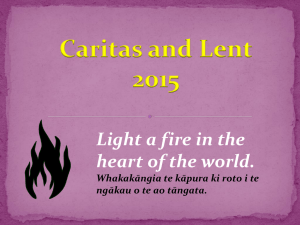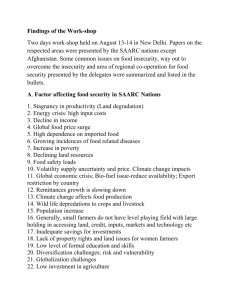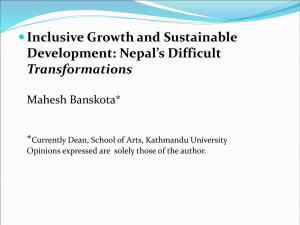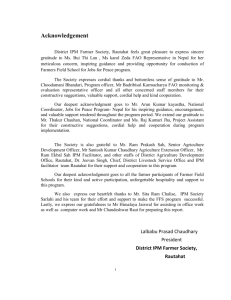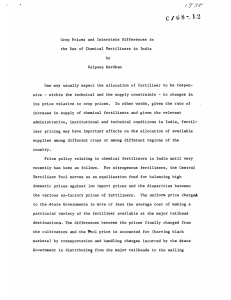Sustainable - Caritas Australia
advertisement
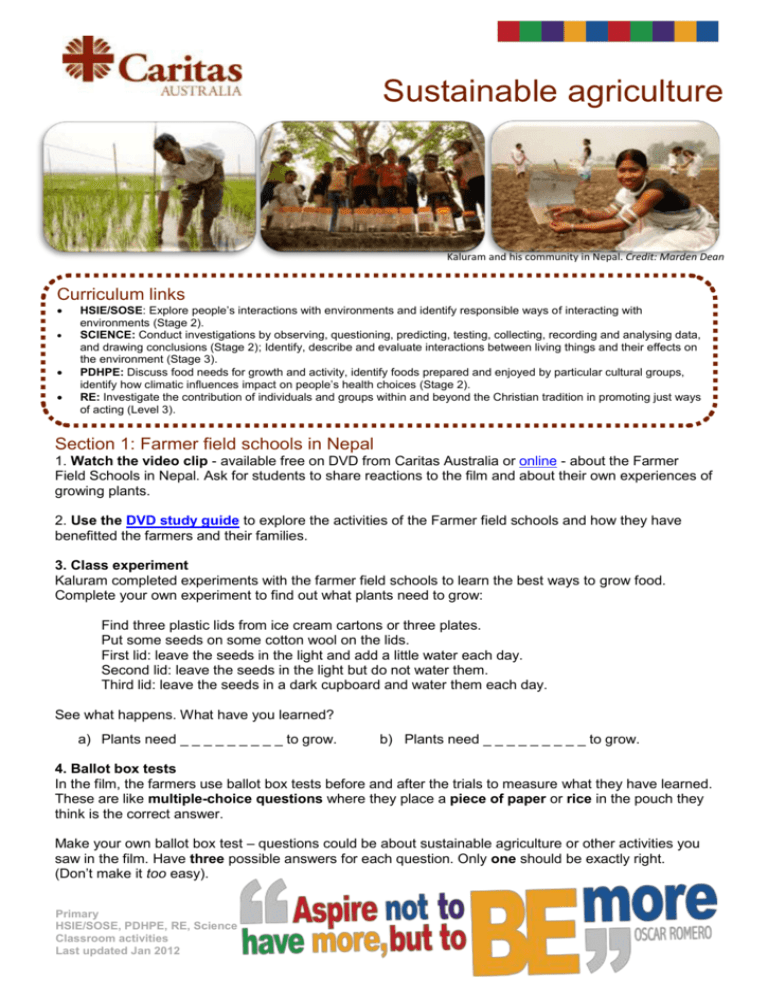
Sustainable agriculture Kaluram and his community in Nepal. Credit: Marden Dean Curriculum links HSIE/SOSE: Explore people’s interactions with environments and identify responsible ways of interacting with environments (Stage 2). SCIENCE: Conduct investigations by observing, questioning, predicting, testing, collecting, recording and analysing data, and drawing conclusions (Stage 2); Identify, describe and evaluate interactions between living things and their effects on the environment (Stage 3). PDHPE: Discuss food needs for growth and activity, identify foods prepared and enjoyed by particular cultural groups, identify how climatic influences impact on people’s health choices (Stage 2). RE: Investigate the contribution of individuals and groups within and beyond the Christian tradition in promoting just ways of acting (Level 3). Section 1: Farmer field schools in Nepal 1. Watch the video clip - available free on DVD from Caritas Australia or online - about the Farmer Field Schools in Nepal. Ask for students to share reactions to the film and about their own experiences of growing plants. 2. Use the DVD study guide to explore the activities of the Farmer field schools and how they have benefitted the farmers and their families. 3. Class experiment Kaluram completed experiments with the farmer field schools to learn the best ways to grow food. Complete your own experiment to find out what plants need to grow: Find three plastic lids from ice cream cartons or three plates. Put some seeds on some cotton wool on the lids. First lid: leave the seeds in the light and add a little water each day. Second lid: leave the seeds in the light but do not water them. Third lid: leave the seeds in a dark cupboard and water them each day. See what happens. What have you learned? a) Plants need _ _ _ _ _ _ _ _ _ to grow. b) Plants need _ _ _ _ _ _ _ _ _ to grow. 4. Ballot box tests In the film, the farmers use ballot box tests before and after the trials to measure what they have learned. These are like multiple-choice questions where they place a piece of paper or rice in the pouch they think is the correct answer. Make your own ballot box test – questions could be about sustainable agriculture or other activities you saw in the film. Have three possible answers for each question. Only one should be exactly right. (Don’t make it too easy). Primary HSIE/SOSE, PDHPE, RE, Science Classroom activities Last updated Jan 2012 5. Pesticides and fertilisers a) In the film, the farmers in Nepal learned to make their own botanical pesticides and fertilisers from readily available natural materials. Why did they need to use pesticides and fertilisers? b) What is the difference between a pesticide and a fertiliser? c) Why is it better for farmers to make their own pesticides and fertilisers than to buy them? (Consider cost, health and environment). d) Research how you can make your own fertiliser from compost. You could set up an experiment to see if your plants grow best in soil without fertiliser or in soil with your compost. 6. What can have an effect on sustainable agriculture? a) Students brainstorm all the factors that cause food insecurity (eg. natural disasters including floods, drought and fire, fertiliser prices, no access to market and insect pests eating crops). b) How is Caritas Australia helping farmers in Nepal to minimise these risk factors? c) Caritas regards its work with the farmers as not only charity but justice. Research our guiding principles on Caritas Australia’s website and try to explain why this is so. 7. Play the Farmer Field School game. Section 2: From farm to plate Students explore similarities and differences between the ways that they obtain their food and the experiences of a student their own age living in rural Nepal. Ask students to draw a diagram that links all the processes. Eg. Farm (production) -> processing -> packaging -> distribution -> supermarket -> home -> waste disposal. Students identify how dependent they are on others to eat the foods they enjoy. As an extension, students could explore ways to reduce the effects each stage in the food journey has on the environment. Eg, don’t buy plastic wrapped bananas, buy food produced closer to home to reduce transport, compost food scraps, etc. A useful example of the production line of potatoes can be found here: http://www.westernpotatoes.com.au/go/consumers/education/farm-to-plate Section 3: The Lorax by Dr Seuss Long before saving the earth became a global concern, Dr. Seuss, speaking through his character the Lorax, warned against mindless progress and the danger it posed to the earth's natural beauty. It is a great story to explore the consequences of unsustainable practices. Section 4: “Give me a fish and I eat for a day. Teach me to fish and I eat for a lifetime”. Explain this statement in the context of sustainable agriculture. Primary HSIE/SOSE, PDHPE, RE, Science Classroom activities Last updated Jan 2012





